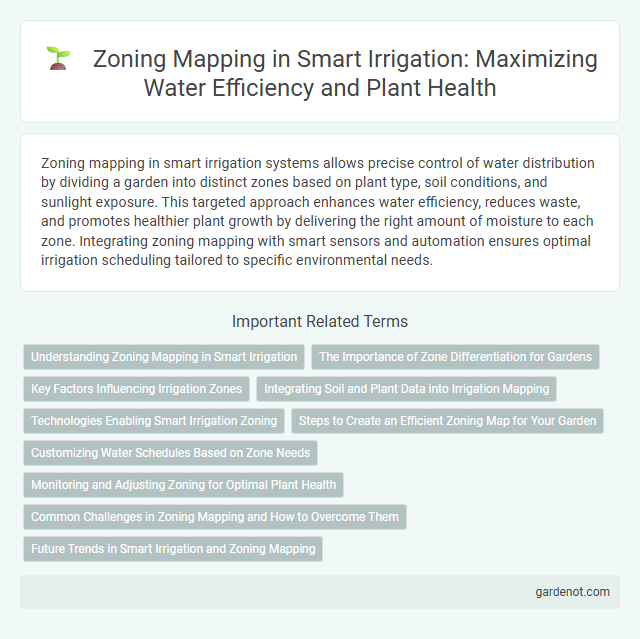Zoning mapping in smart irrigation systems allows precise control of water distribution by dividing a garden into distinct zones based on plant type, soil conditions, and sunlight exposure. This targeted approach enhances water efficiency, reduces waste, and promotes healthier plant growth by delivering the right amount of moisture to each zone. Integrating zoning mapping with smart sensors and automation ensures optimal irrigation scheduling tailored to specific environmental needs.
Understanding Zoning Mapping in Smart Irrigation
Zoning mapping in smart irrigation involves dividing a landscape into distinct zones based on soil type, plant needs, sunlight exposure, and water requirements to optimize irrigation efficiency. This process uses data from sensors, weather forecasts, and soil moisture levels to create precise watering schedules tailored for each zone. Proper zoning mapping reduces water waste, promotes healthier plant growth, and enhances overall system performance.
The Importance of Zone Differentiation for Gardens
Zone differentiation in smart irrigation enhances water efficiency by tailoring moisture levels to each garden area's specific needs. Implementing precise zoning mapping allows for targeted hydration, reducing waste and promoting optimal plant health. Distinct zones facilitate smart system programming, adapting irrigation schedules according to soil type, plant species, and sun exposure, maximizing garden productivity.
Key Factors Influencing Irrigation Zones
Irrigation zoning relies heavily on soil type, plant water requirements, and topography to optimize water distribution and enhance crop yield. Precise soil moisture levels and evapotranspiration rates guide the segmentation of irrigation zones for efficient water use. Integrating weather patterns and system capacity ensures each zone receives tailored irrigation, minimizing water waste and promoting sustainable farming practices.
Integrating Soil and Plant Data into Irrigation Mapping
Integrating soil and plant data into zoning mapping enhances smart irrigation by tailoring water delivery to specific soil types and crop needs, optimizing water usage efficiency. This precise mapping leverages soil moisture levels, texture, and plant water requirements to create distinct irrigation zones, reducing wastage and promoting healthy crop growth. Advanced sensors and geographic information systems (GIS) enable real-time data collection and dynamic adjustments, ensuring irrigation schedules are both responsive and sustainable.
Technologies Enabling Smart Irrigation Zoning
Advanced remote sensing technologies such as drone-based multispectral imaging and soil moisture sensors enable precise zoning mapping for smart irrigation systems, optimizing water distribution based on real-time field variability. Geographic Information Systems (GIS) integrate spatial data to delineate irrigation zones, enhancing decision-making through detailed soil, crop, and topography analysis. Smart controllers then use this zoned data to automate irrigation schedules, significantly improving water efficiency and crop yield.
Steps to Create an Efficient Zoning Map for Your Garden
Begin by analyzing your garden's soil types, sun exposure, and plant water needs to identify distinct irrigation zones. Use GPS or mapping software to accurately delineate each zone, ensuring precise application of water. Regularly update the zoning map to reflect seasonal changes and plant growth for optimal water efficiency.
Customizing Water Schedules Based on Zone Needs
Zoning mapping in smart irrigation allows precise customization of water schedules according to the unique needs of each zone, optimizing water usage efficiency. Soil type, plant species, sun exposure, and slope are key factors analyzed to tailor irrigation timing and volume. This targeted approach significantly reduces water waste while promoting healthier, more resilient landscapes.
Monitoring and Adjusting Zoning for Optimal Plant Health
Zoning mapping in smart irrigation enables precise monitoring of water distribution tailored to specific plant needs, ensuring each zone receives the ideal moisture levels. Advanced sensors and real-time data analytics detect soil moisture variations, allowing for dynamic adjustments that prevent overwatering or drought stress. This targeted approach optimizes plant health, conserves water resources, and enhances overall landscape sustainability.
Common Challenges in Zoning Mapping and How to Overcome Them
Zoning mapping in smart irrigation often faces challenges such as soil variability, microclimate differences, and inaccurate sensor data, which can lead to uneven water distribution and reduced crop yield. Overcoming these issues requires deploying high-resolution soil moisture sensors, integrating weather station data, and implementing machine learning algorithms for real-time zone adjustments. Leveraging geospatial technology and remote sensing further enhances zoning accuracy, ensuring efficient water use and optimal plant health.
Future Trends in Smart Irrigation and Zoning Mapping
Zoning mapping in smart irrigation is advancing with AI-driven analytics that enable precise water distribution based on soil types, crop needs, and microclimate variations. Future trends highlight the integration of IoT sensors and satellite imagery for real-time monitoring and adaptive irrigation scheduling, enhancing water efficiency and crop yield. Emerging technologies such as machine learning algorithms improve predictive modeling, optimizing zone-specific irrigation plans and reducing resource waste.
Zoning mapping Infographic

 gardenot.com
gardenot.com